![]()
![]()
![]()
Use LEFT and RIGHT arrow keys to navigate between flashcards;
Use UP and DOWN arrow keys to flip the card;
H to show hint;
A reads text to speech;
127 Cards in this Set
- Front
- Back
|
Pierce's Disease
|
The bacterium that causes it lives in the water-conducting system of the plants (xylem).
Symptoms appear when a significant amount of xylem becomes blocked by the growth of the bacteria. It spreads from plant to plant by sap-feeding insects that feed on the xylem. |
|
|
Pierce's Disease
|

Grapevine xylem vessel colonized by X. fastldolso bacteria
|
|
|
Pierce's Disease Symptoms
|
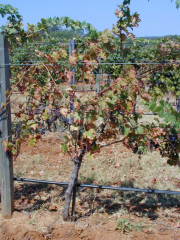
Symptoms first appear as water stress in midsummer, caused by blockage of the water-conducting system by the bacteria.
|
|
|
Pierce's Disease Symptoms
|
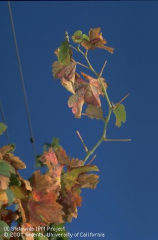
Dried leaves fall leaving the petiole attached to the shoot.
|
|
|
Pierce's Disease Symptoms
|
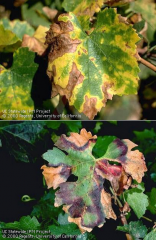
Leaves become slightly yellow or red along margins in white (top) and red (bottom) varieties.
|
|
|
Pierce's Disease Symptoms
|
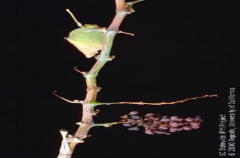
Fruit clusters shrivel or raisin. Wood on new canes matures irregularly, producing patches of green, surrounded by mature brown bark.
|
|
|
Glassy Winged Sharpshooter
|
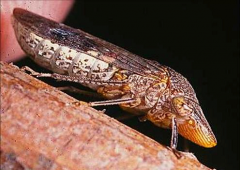
This vector is a serious threat to CA vineyards because it moves faster and flies greater distances into vineyards than the other species of sharpshooters.
|
|
|
Glassy Winged Sharpshooter
|
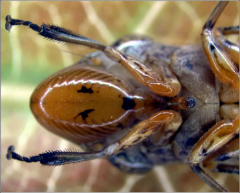
Occurs in unusually high numbers in citrus and avocado groves and some woody ornamentals.
|
|
|
Glassy Winged Sharpshooter Control
|
Insecticide sprays and cultural practices
(severe pruning, removal of infected vines and avoiding planting vineyards near citrus orchards) |
|
|
V. arizonica
|
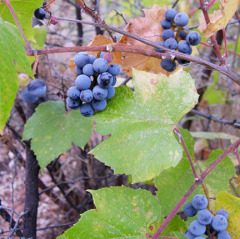
Resistant to Pierce's Disease.
|
|
|
What are pests?
|
Organisms that damage or interfere with grapevines. May not cause direct damage, but may transmit disease which in turn can affect vine health.
|
|
|
A pest can be:
|
invertebrate (insect, mite)
nematode vertebrate (bird, rodent or mammal) plant (weed) |
|
|
Bird Types
|
Starlings, Finches, Sparrows, Robins, Jays, Bluebirds, Blackbirds
|
|
|
Bird Damage
|
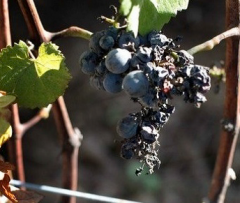
The loss of crops could be as high as 10-20% more.
Peck at fruit, or remove entire berry, and if the berries are damaged then pathogens can invade and spread throughout the bunches. |
|
|
Starlings
|
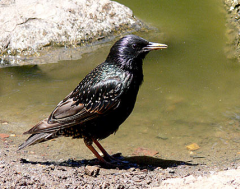
- They are probably the most troublesome of the different bird species that can feed on grape berries
-Outside of the breeding season, they feed and roost together in flocks - classifies as non-game and may be killed at any time |
|
|
Bird Management
|
- Noisemakers (cracker shells, propane exploders and electronic devices
- visual repellents such as bright objects (flash tape) |
|
|
Bird Management Biocontrol
|
Falcons can be used to scare off the starlings in vineyards because they can spot starlings from a half-mile away.
|
|
|
Wild Life Pests: Jackrabbits
|
Jackrabbits: bark removed by rabbit gnawing, this may severely damage the phloem.
|
|
|
Wild Life Pests: Ground Squirrels
|
Ground squirrels: Burrow systems near trees or vines can damage the root system. Damage young vines by girdling trunks, and burrows can be very destructive with hazards to people and machinery
|
|
|
Wild Life Pests: Deers
|
May completely strip vines of foliage.
Severe stunting of vines can result from repetitive deer browsing. |
|
|
Wild Life Pests: coyotes
|
Damage of the drip irrigation system
|
|
|
Integrated management of vertebrate pests
|
- population monitoring
- habitat management -biocontrol - exclusion - trapping -chemicals - cultural practices |
|
|
Leaf pests
|
- grape leafhoppers
- sharpshooters - western grapeleaf skeletonizer - grape leaffolder - spider mites |
|
|
Fruit pests
|
- mealybug
- orange tortrix - thrips |
|
|
Bud or new growing shoot tip pests
|
- cutworms
- bud beetle |
|
|
root pests
|
- phylloxera
- nematodes |
|
|
Biological control
|
the use of natural enemies to control pests and their damage.
|
|
|
Cultural control
|
practices that reduce pest establishment, reproduction, dispersal and survival. Like changing irrigation practices
|
|
|
Mechanical and physical controls
|
Kill a pest directly or make the environment unsuitable for it. Traps for rodents are mechanical. Mulches for weed management are physical.
|
|
|
Chemical control
|
The use of pesticides. Are used in IPM only when needed and in combination with other approaches.
|
|
|
Economic Thresholds (ETs)
|
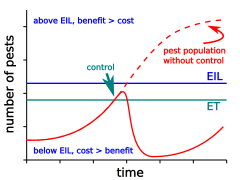
Are applied to determine whether and when control measures are warranted.
|
|
|
Insect Mouth Parts
|
- Determine what the insect eats
- they type of damage on the grapevine depends on the type of feeding behavior of the pest and whether it vectors a bacteria or viral disease - we can infer the type of insect by looking at the type of feeding damage. |
|
|
Insect Mouth Parts Shape
|
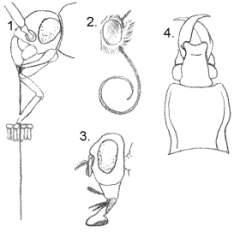
1. Piercing sucking (mosquitoes, fleas, aphids, mealybugs)
2. Siphoning (diptera) 3. Sponging (lepidoptera) 4. Biting / chewing (beetles, catepillars, grasshoppers) |
|
|
Rasping-sucking
|
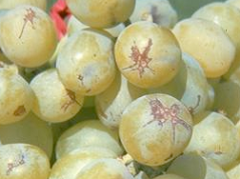
Starfish pattern on berry scarring caused by thrips feeding on young grape berries.
|
|
|
Piercing-sucking
|
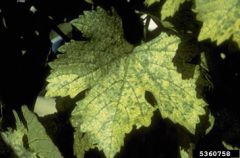
Damage to grape leaves caused by leafhoppers
|
|
|
Biting - chewing
|
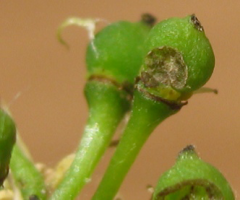
Larval feeding of Orange Tortrix damage to berries
|
|
|
Holometabolism (complete metamorphosis)
|

Four life stages: as an embryo or egg, a larva, a pupa and an imago or adult
EX: grape amnivorous leafrollers |
|
|
Hemimetabolism (incomplete metamorphosis)
|

EX: variegated western grape leafhopper
|
|
|
Insect Predators
|
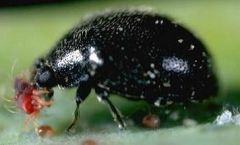
- Beetles, true bugs, lacewings, flied, midges, spiders, wasps, and predatory mites
- can be found throughout plants - some are specialized in their choice of prey and others are generalists - EX Spider mite destroyer lady beetle |
|
|
Insect Parasitoids
|

- have an immature life stage that develops on or within a single insect host, ultimately killing the host
- wasps or flies - most only attack a particular life stage of one or several related species |
|
|
Pheromones
|
Chemical produced by insects for communication; substances secreted to the outside (exocrine glands) by one individual and received by a 2nd individual of the same species in which they elicit a specific reaction.
We can exploit pheromone production for IMP programs |
|
|
Pheromone dispenser
|
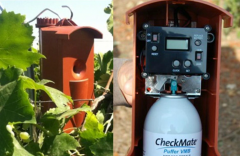
|
|
|
Pheromone dispenser
|
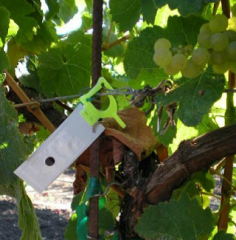
|
|
|
Lobesia botrana (European grapevine moth)
|
Native to Mediterranean Europe, it was reported for the first time in the US in Napa Valley in October of 2009.
|
|
|
European Grapevine Moth larvae
|
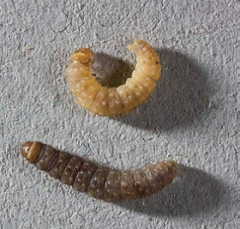
Young larvae are creamy white with black heads. Older larvae are tan to yellow-brown, turning dark green or maroon as they mature.
|
|
|
European Grapevine Moth larvae
|
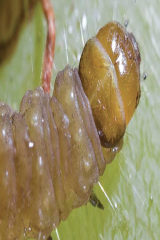
They have visible white tubercules at the base of the body hairs.
|
|
|
European Grapevine Moth overwinters
|
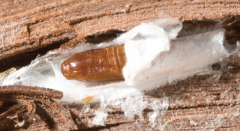
Overwinters as pupa under the bark
|
|
|
European Grapevine Moth
|

Heads are tan to yellow-brown, with a distinct dark border on the outer edge of first segment behind the head.
|
|
|
European grapevine moth first generation feeding
|
In May and June, larvae web and feed on the flower clusters
|
|
|
European grapevine moth second generation feeding
|
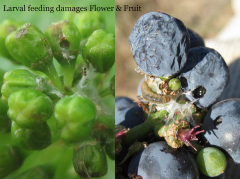
Second-generation larvae (July-August) feed on green berries. Young larvae penetrate the berry and hollow them out, leaving the skin and seeds
|
|
|
European grapevine moth third generation feeding
|
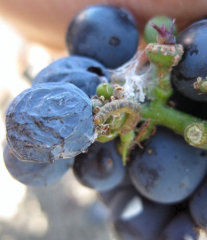
Third-generation larvae (August-September) cause the greatest damage by webbing and feeding inside berries and within bunches, which become contaminated with frass (excrement).
Additionally, feeding damage to berries after veraison exposes them to molds and secondary pests such as raisin moth and fruit flies. |
|
|
European Grapevine moth monitoring
|
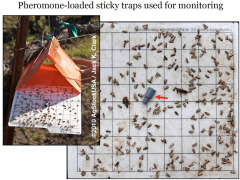
Sex pheromone attracts males and is used to monitor male flights
|
|
|
European Grapevine moth monitoring
|
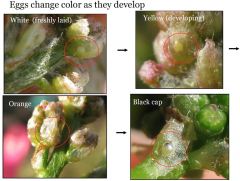
Monitoring by visual inspection of egg deposition on clusters
|
|
|
Orange Tortrix
|
- Generally considered a pest of grapes in the coastal areas and valleys were there is a marine influence
- causes the same kind of damage as the omnivourous leafroller in inland areas - if a problem, encourage biological control by the judicious use of insecticides |
|
|
Orange Tortrix feeding
|
Overwintering larvae feed on any soft, exposed vine tissue, weeds and in grape mummies on the vine. Spring feeding is on buds, and leaves. Larvae then enter the bunches was early as bloom time and make nests of webbing among the berries. Besides injury to leaves and berry stems, their feeding on berries allows entry of bunch rot disease organisms
|
|
|
Orange Tortrix larvae feeding on grapes
|
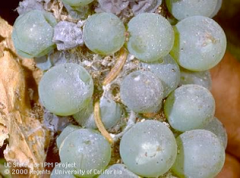
|
|
|
Orange Tortrix larvae feeding on buds
|

|
|
|
Orange Tortrix adults and an egg mass
|
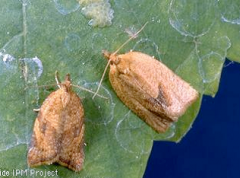
|
|
|
Omnivorous leafroller
|
- Can cause serious damage in CA central valley and inner coastal vineyards.
- Feeds on leaves, flowers, and berries pre and after veraison - most significant damage occurs after veraison when feeding allows rot organisms to enter fruit at the damage sites |
|
|
Omnivorous leafroller overwinters
|
Overwinters in the larval stage in grape mummies, vineyard weeds, and other trash in the vineyard
|
|
|
Omnivorous leafroller control
|
During the dormant season, remove mummy clusters and control vineyard weeds. French plow and disc clusters and weeds to bury overwintering larvae living on weeds in ground duff and dried berries. During dormancy, prune out old fruit mummies and destroy by flailing or shredding
|
|
|
Larva of the omnivorous leafroller folding a leaf
|
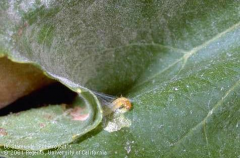
Larva on the omnivorous leafroller folding a leaf by tying edges together with silk threads
|
|
|
Larva of omnivorous leafroller webbing
|

Webbing nest on young grape berries
|
|
|
Omnivorous leafroller adult
|
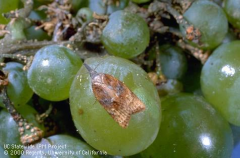
|
|
|
Grape Leaffolder
|
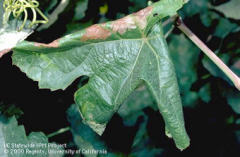
- parasites play an important role in keeping grape leaffolder below a level that will cause damage.
- can reduce leaf surface by constructing leaf rolls and by leaf feeding - damage can be tolerated to a certain point |
|
|
Bracon cushmani
|
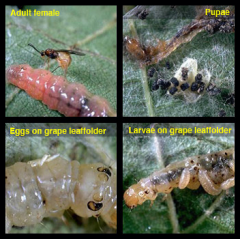
-parasitoid
- adults are small wasps - after stinging and paralyzing leaffolder larvae, females lay from one to several eggs on the body of the larvae - larvae feed externally and after completing their development, pupate next to the consumed host - parasitism by this parasite frequently reduces host populations to below economic levels |
|
|
Variegated Cutworm
|
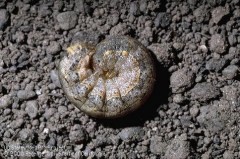
- variegated cutworm is the predominant species in the San Joaquin Valley and North Coast
|
|
|
Spotted Cutworm
|
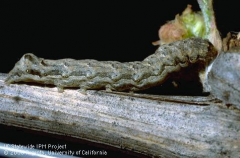
Predominant in the central coast counties
|
|
|
Cutworm
|
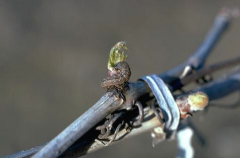
- Feeding on grapevines occurs from bud well to when shoots are several inches long. Injured buds may fail to develop. Grapevines can compensate for early season damage to buds or shoots to some extent by the growth of secondary buds. The fruitfulness of secondary buds, however, varies according to variety
|
|
|
Enemies of Cutworm
|
Predaceous or parasitic insects, mammals, parasitic nematodes, pathogens, birds and reptiles
|
|
|
Thrips
|
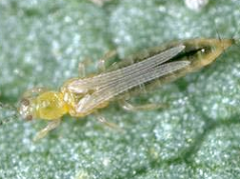
Small insects, 0.04 inch long, with distinctive feather wings. Colo varies from yellow to brown in color. They have rasping-sucking mouthparts. They are the most important species causing damage on grapes.
|
|
|
Thrips feeding
|
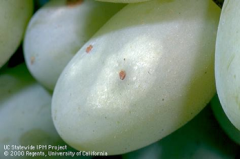
They create halo-spotting on the fruit when they oviposit in berries during bloom and up to fruit set or shortly thereafter. Can scar berries with their feeding, which renders table grapes unmarketable.
|
|
|
Western Grapeleaf skeletonizer
|
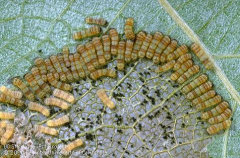
Does not occur in all grape-production areas because the moths are not long distance fliers and this pest has been slow to spread in CA. Keeps populations below economically damaging levels. Usually controlled with insecticides that are also effective on caterpillars and leafhoppers
|
|
|
Western Grapeleaf Skeletonizer First instar
|
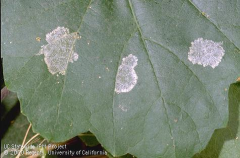
Feed on the lower leaf surface, leaving only the veins and upper cuticle. This gives leaves a whitish paperlike appearance; eventually the entire leaf turns brown.
|
|
|
Western Grapeleaf Skeletonizer late fourth instar larvae
|
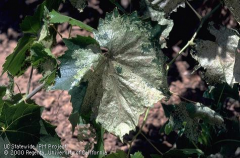
skeletonize the leaves, leaving only the larger veins. when abundant, larvae can defoliate vines by July.
|
|
|
Western grape leafhopper
|
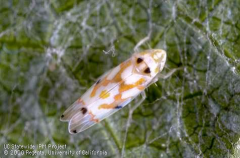
Pest of grapes especially in the San Joaquin, Sacramento, and North Coast Valleys. It is also a problem in warmer, interior Central Coastal Valleys.
|
|
|
Variegated leafhopper
|
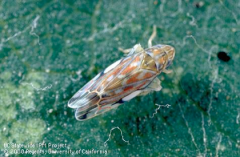
The major pest of grapes in southern CA and in the Central Valley as fro north as San Joaquin Country
|
|
|
Leafhoppers
|
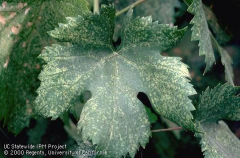
Nymphs and adults of both species remove the contents of leaf cells. Loss of leaf efficiency and leaf drop can occur when leafhopper densities are extremely high. This can result in fruit sunburns. Vines can tolerate fairly high populations without harm. Cause leaf stippling.
|
|
|
Pacific Spider Mite
|
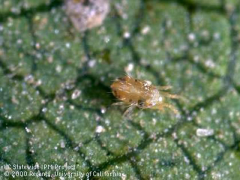
Primary pest mite species in the San Joaquin Valley and may also be the primary pest mite in certain North Coast grape growing areas. Pacific spider mite prefers the warmer upper canopy of the vine. Although it can cause damage early in the season, they prefer the hotter dyer part of the season.
|
|
|
Willamette Spider Mite
|
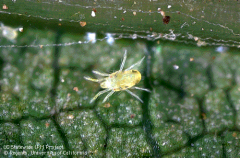
It is a pale yellow. It is often considered an early-season mite. Prefers cooler parts of plant. Populations can persist throughout the growing season. Primarily problem in Salinas Valley and Sierra foothill and causes economic damage to Zin.
|
|
|
Twospotted Spider Mite
|
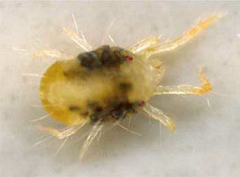
Tetranychus uritace, is almost identical to Pacific mite except it rarely has spots on the rear of the body. It is only occasionally found on grapes in CA and rarely causes damage.
|
|
|
Pacific Spider Mite Damage
|
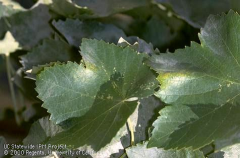
Begins as yellow spots between leaf veins. As damage progresses, dead (necrotic) areas appear on the leaves.
|
|
|
Willamette spider mite damage
|
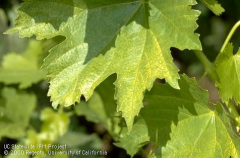
feeding in mid or late seasons causes foliage to turn yellowish bronze. In red varieties, infested leaves may turn reddish. These mites feed along the veins.
|
|
|
Mite Management
|
Many natural enemies help to control pest mite populations (sixspotted thrip, spider mite destroyer, and western predatory mite)
Apply water or other materials formulated to reduce dust on roads in the vineyard because dust contributes to spider mite populations. |
|
|
Mealybug
|
They damage grapes by contaminating clusters with cottony egg sacs, larvae, adults and honeydew. Often the honeydew is covered with a black sooty mold. All species can transmit grape viruses.
Parasites and predators can help, but honeydew-seeking ants must be controlled. |
|
|
Gape Mealybug
|
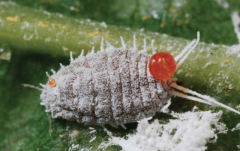
Excreted fluid is reddish orange
|
|
|
Obscure mealybug
|
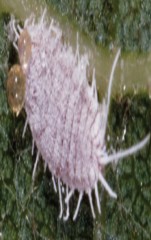
fluid excreted is clear.
|
|
|
longtailed mealybug
|

similar in appearance to the other two species but has much longer waxy filaments on the posterior end. They are only a problem in Central Coast vineyards.
|
|
|
Grape Mealybug biological control
|
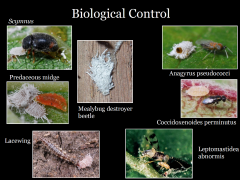
|
|
|
PHYLLOXERA
|
- tiny aphidlike insext that feeds on V. vinifera grape roots, stunting growth of vines or killing them.
- damages the root systems of grapevines by feeding on the root, either on growing rootlets, which then sell and turn yellowish, or on mature hardened roots where the swellings are often hard to see |
|
|
Tuberosities
|
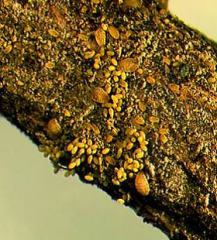
Galls formed on woody, mature storage roots. High numbers of them limit root function, resulting in aboveground symptoms of reduced vine growth and fruit production, possibly correlated with water stress and nutrient deficiencies.
|
|
|
Nodosities
|
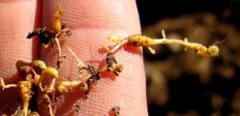
Primary and secondary roots. Galls on feeder root tips and roots that have not suberized
|
|
|
Phylloxera
|
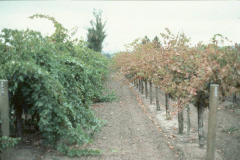
-Native to the eastern and southern US
-Rupestris, berlandieri, and riparia are resistant -vinifera are susceptible - introduced to Europe in 1863 and destroyed 75% of vineyards by 1900 - spread to CA by 1870 |
|
|
Phylloxera expectations on Vinifera
|
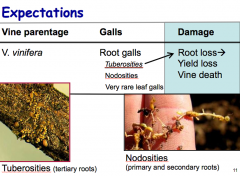
|
|
|
Phylloxera expectations on american vitis
|
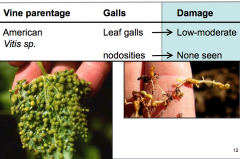
|
|
|
Phylloxera life cycle
|
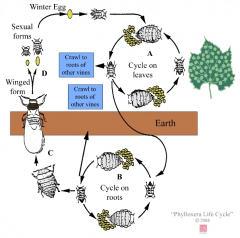
- the insect has both below ground and aerial portions to its life-cycle
- rarely see the above ground type - below ground insect can kill grapevines |
|
|
Phylloxera root galls
|
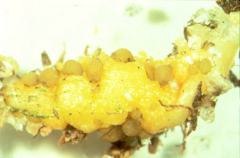
|
|
|
Phylloxera leaf galls
|
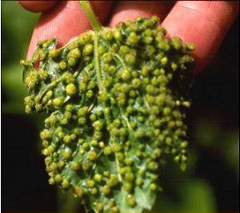
|
|
|
Nematodes
|
The most abundant multi-cellular animal on the planet are unsegmented round worms that inhabit soil, freshwater and marine environments. Parasite that feed externally or internally in roots or other tissues.
|
|
|
Damages Caused by nematodes
|
- mechanical injury to cells and tissues
- causes cell death - modify cell development and function - disrupt uptake of water and nutrients |
|
|
Symptoms of nematode infections
|
- stunting, slow growth, diebakc
- chlorosis and nutrient deficiencies - wilting and reduced yield - lack of response to other treatments - root stunting and proliferation - galls at root tips and lesions |
|
|
Root knot nematode
|
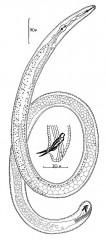
Meloidogyne spp.
Produce small galls on the roots (.125 in diameter), but they can be larger when multiple infections cause galls to coalesce. |
|
|
Dagger nematode
|
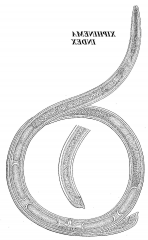
Xiphinema index
Feeds on root tips causing them to swell in a manner similar to the nodosities Virus transmission by dagger nematode produces symptoms on leaves such as yellowing veins, mosaic, and malformation with symptom expression less apparent among white varieties and in warmer regions. |
|
|
Nematode Pre-plant management
|
- planting site selection, non-host rotation
- deal with replant problem issues - preplant soil disinfestation, nematicides - clean equipment, water - certified planting stock - rootstock selection - biological antagonists and soil food web health |
|
|
Nematode post-plant management
|
- amendment
- nematicieds - cover crops - biological antagonists and soil food web health |
|
|
Conventional Farming fungicides
|
- synthetic chemical
- natural organic chemical (B, Cu, S, Oils) - biological (beneficial fungi and bacteria) |
|
|
Organic farming fungicides
|
Natural organic chemical and biological
|
|
|
Biodynamic farming fungicides
|
- it is a method of organic farming originally developed by Rudolf Steiner. It is described as a holistic understanding of agricultural processes
- natural organic chemical - biological - mystical, spiritual, astronomical |
|
|
Fungicides mobility in the plant
|
- contact: protectant
- systemic: penetrant |
|
|
Fungicides role in protection
|
- preventative: contact
- curative: systemic - both: systemic |
|
|
Fungicides breadth of activity
|
- single site: active against one point in the metabolic pathway or single critical enzyme or protein of the fungus. Highly specific, systemic properties, higher chances of resistance
- multi sites: active against several point, enzymes, proteins of the fungus, broad, contact, lower chances of resistance |
|
|
Type of chemical in fungicide
|
- organic: contains carbon atoms
- inorganic: no carbon atoms |
|
|
Foliage sprays and dusts of fungicides (foliar diseases) application
|
-lime: reduce fungicide phytotoxicity
- surfactants: fungicide spread better, increase coverage - stickers: fungicide stick better to plant parts |
|
|
Treatment of tree wounds (wood diseases) applications
|
by hand, back-pack or tractor
|
|
|
Soil treatment application (soil borne diseases, foliar diseases)
|
- establishment of vineyard (fumigants)
- in the drip line |
|
|
Factors influencing spray intervals
|
- type of fungicide
- persistence or residual life of the fungicide - time of the year - weather - type of disease - coverage |
|
|
Fungicide resistance
|
It is a stable, heritable trait, obtained by evolutionary processes that result in a reduction in sensitivity to a fungicide.
Fungicides with single-site mode of action are at relatively high risk for resistance compared to multi-sites. fungal populations with sexual reproduction and many life cycles are more likely to develop resistance |
|
|
Qualitative resistance
|
modification of a single gene that confers high resistance or sensitivity to fungicides. Change active ingredient
|
|
|
Quantitative resistance
|
modification of several interacting genes that confers a range of sensitivity to fungicide for a given population of a pathogen. Increase concentration, change of active ingredient.
|
|
|
Cross-resistance
|
resistance to fungicides with similar more of action
|
|
|
Why control weeds
|
-compete for water, nutrients, and light with grapevines
- interference is especially problematic during establishment years - can affect crop management, irrigation, and harvest operations - impacts on other pest problems - crop quality conerns |
|
|
Integrated weed management (IWM)
|
Using all available strategies to manage weed populations in a manner that is economically and environmentally sound.
|
|
|
Integrated weed control: sanitation (prevention)
|
- scout and manage in the vineyard
- manage weeds on field margins and access roads - clean equipment between sites - scout and prevent seed set |
|
|
Integrated weed control: biological controls
|
not currently very applicable to vineyard systems
|
|
|
integrated weed control: cultural practices
|
- irrigation and fertilization management
- canopy management - cover crops - mulches |
|
|
integrated weed control: mechanical
|
- flaming
- animals - tillage/ cultivation, mowing, hand labor |
|
|
integrated weed control: chemical
|
- herbicides (usually applied under vine strips)
- preemergence (PRE) - postemergence (POST) |

